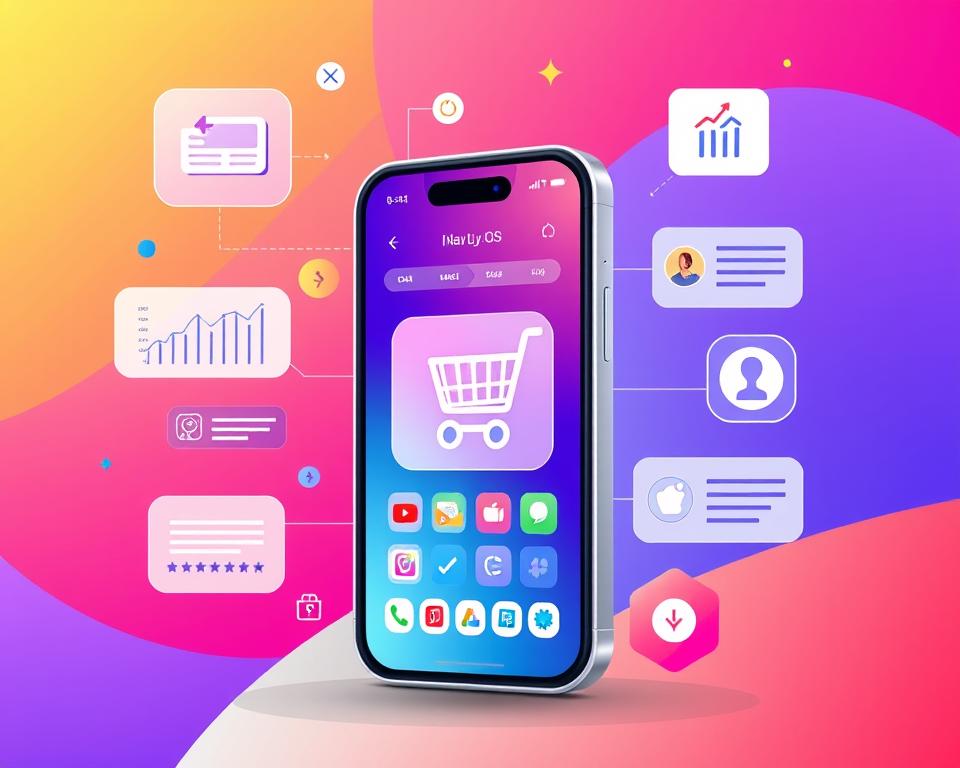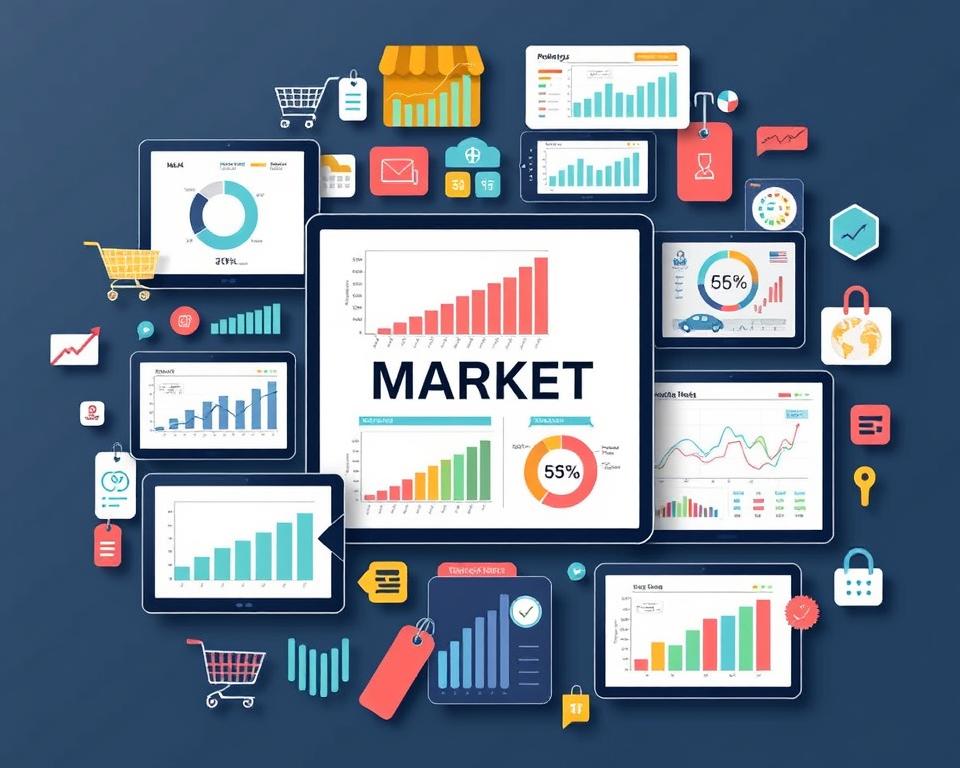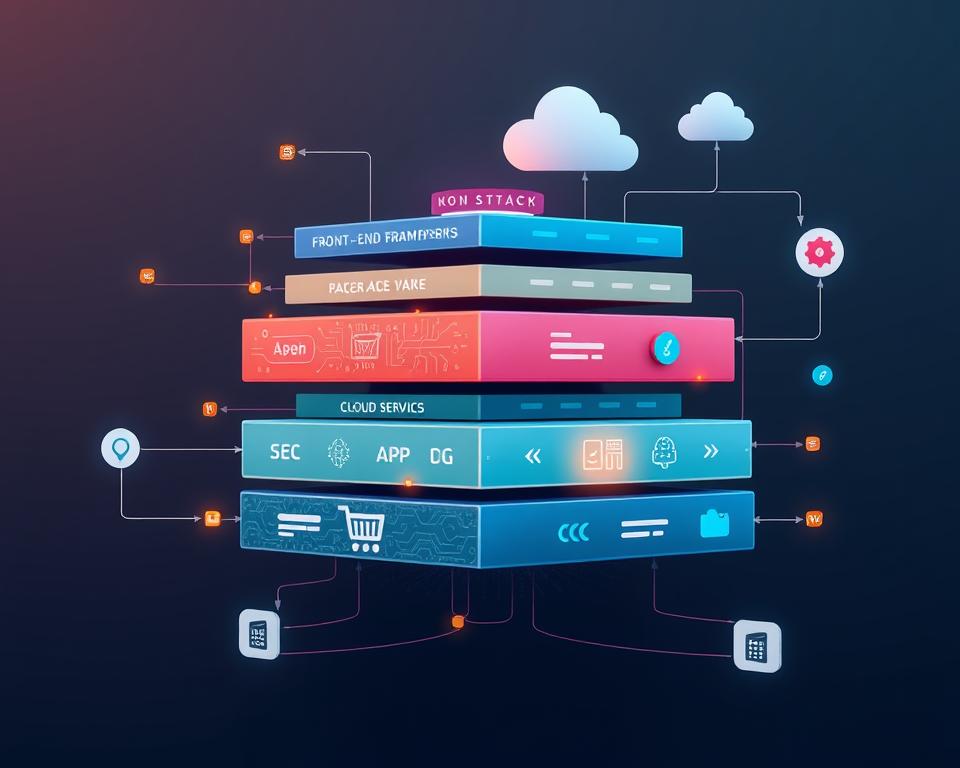The ecommerce world has changed how we shop and do business. Making a successful ecommerce app is key for businesses wanting to grow online. It can help you reach more customers, sell more, and make more money.
This guide will show you how to build an ecommerce app that attracts and keeps customers. We’ll cover everything from understanding the market to adding the latest features and keeping your app safe. You’ll learn how to turn your idea into a successful online store.
Table of Contents
Key Takeaways
- Gain a deep understanding of the ecommerce market trends and consumer behavior
- Identify the right ecommerce business model for your unique needs
- Develop a comprehensive strategy for your ecommerce app development project
- Ensure your app is equipped with essential features that enhance the user experience
- Implement robust security measures and seamless payment gateway integration
- Optimize your app for success through rigorous testing and continuous improvement
- Leverage effective app store optimization and launch strategies to maximize visibility and adoption
Understanding the Ecommerce App Landscape
The eCommerce market has grown a lot in recent years. This growth is thanks to more people using mobile apps and changing what they want. It’s key to know the current trends, business models, and top eCommerce platform success stories.
Current Market Trends and Statistics
The eCommerce industry has seen a big jump, with sales expected to hit $5.4 trillion by 2026. This increase is because of more smartphones and the ease of shopping on them. Now, mobile shopping makes up over 72% of all eCommerce, showing how important good eCommerce apps are.
Types of Ecommerce Business Models
- B2B (Business-to-Business) models, such as Shopify, help businesses sell to other businesses.
- B2C (Business-to-Consumer) models, like Amazon, focus on making shopping easy for individual customers.
- C2C (Consumer-to-Consumer) platforms, like Etsy, let people sell directly to other consumers.
Key Players and Success Stories
Big names in eCommerce, such as Amazon, Etsy, and Shopify, have set the bar high. They’ve not only grown with the market but also innovated to meet customer needs. They keep delivering great experiences and growing fast.
| Platform | Business Model | Key Features | Success Metrics |
|---|---|---|---|
| Amazon | B2C | Wide product range, personalized suggestions, easy checkout | $469.8 billion in revenue (2021), 200 million+ Prime members |
| Etsy | C2C | Specialized in handmade and vintage items, easy seller tools | $2.3 billion in revenue (2021), 96.3 million active buyers |
| Shopify | B2B | Full eCommerce platform, customizable stores, payment options | $1.5 billion in revenue (2021), 1.7 million+ businesses using it |
Knowing the current trends, business models, and success stories helps you make a better eCommerce app. It ensures your app can thrive in the digital world.
Essential Features for Your Ecommerce App
Creating a successful ecommerce app means picking the right features. These features make the app better for users, increase sales, and keep customers coming back. Let’s look at the key elements your app should have:
User Registration and Profiles
It’s important to let users create accounts and manage their profiles. This feature allows for personalized shopping experiences. Users can see their order history, save payment methods, and get product recommendations tailored just for them.
Comprehensive Product Catalog
Your app should have a detailed product catalog for customers to explore. It’s key to have clear product descriptions, high-quality images, and easy-to-use filters. This makes shopping a fun and engaging experience.
Seamless Search Functionality
A strong search functionality helps customers find what they need fast. Features like predictive search and filtered results make finding products easier. This can lead to more sales and happy customers.
Intuitive Shopping Cart
A good shopping cart is crucial for any ecommerce app. Users should be able to add, remove, and manage items easily. They should also be able to see order details and check out securely.
Secure Payment Integration
Having a smooth and secure payment integration is vital for trust and lower cart abandonment. Use trusted payment gateways, offer various payment options, and protect payment data. This is key for a successful app.
By adding these essential features, you can make an ecommerce app that’s easy to use and fun to shop on. This leads to happy customers, loyalty, and a growing online business.
Planning Your Ecommerce App Development Strategy
Creating a solid ecommerce app development strategy is key to success. It involves understanding your target audience, setting realistic goals, and choosing the best development method. This ensures your app meets your vision.
Defining Your Target Audience
Market research is crucial for knowing your audience. Look into their likes, behaviors, and what they struggle with. Use this info to create user personas that guide your app’s design and features. This way, your app will connect with the right customers from the start.
Setting Project Timeline and Budget
Good project management is vital for a timely and budget-friendly app launch. Plan a timeline that considers your app’s complexity, your team’s schedule, and possible delays. Also, make a detailed budget for all costs, from planning to updates.
Choosing the Right Development Approach
The choice between native or hybrid app development is crucial. Native development gives top performance and smooth device integration. Hybrid development is quicker and works on more platforms. Choose wisely based on your goals and audience.
“Successful ecommerce app development is all about striking the perfect balance between strategic planning and technical execution.”
Technical Requirements and Architecture Setup
Building a strong ecommerce app needs a solid technical base. The right tech stack, flexible API integration, and reliable cloud hosting are key. They can make or break your app’s success.
Choosing the right tech stack is crucial. You’ll need to think about programming languages, frameworks, databases, and server technologies. React, Angular, or Vue.js are good for the frontend, while Node.js, Python, or PHP work well for the backend. It’s important that your tech stack can grow with your app.
API integration is also vital. It lets your app talk to third-party services like payment gateways and shipping providers. Good APIs make workflows smoother and improve user experience.
Cloud hosting brings many benefits, like better scalability, security, and less upkeep. Choosing a top cloud platform like AWS, Google Cloud, or Microsoft Azure is smart. It helps your app perform well in the fast-paced ecommerce world.
Planning your technical setup well and aligning it with your business goals is key. This sets a strong base for your ecommerce app. It paves the way for success and growth in the long run.
“Successful ecommerce apps are built on a solid technical foundation that can adapt and scale with the business.”
How to Develop an eCommerce Marketplace App
Creating an eCommerce marketplace app needs a smart plan. This plan covers the backend, frontend, and database. Let’s explore the main parts of building these key elements.
Backend Development Process
The core of an eCommerce app is its server-side programming. It’s about setting up a strong backend. This part handles user management, product listing, order processing, and payments.
Developers must design the backend well. They need to make sure all parts work together smoothly. This ensures the app runs fast and efficiently.
Frontend Development Steps
The app’s look and feel is crucial. Developers must make the frontend user-friendly and attractive. They need to create layouts that work on all devices and ensure the app is easy to use.
Database Structure and Management
A good database is key for managing data. Developers must plan the database carefully. They need to think about data types, how data is connected, and how to make queries fast.
Good database management is also important. This includes making backups and ensuring the app can grow with more users.
| Backend Development | Frontend Development | Database Management |
|---|---|---|
|
|
|
By planning well and executing the backend, frontend, and database, developers can make a strong eCommerce app. This app will offer a great user experience and meet the needs of its users.
Designing User Interface and Experience
Making a great user interface (UI) and user experience (UX) is key for any ecommerce app’s success. Developers need to focus on responsive design and a mobile-first approach. This makes the app look good and easy to use.
Responsive design means the app works well on all devices. It looks good on phones, tablets, and computers. A mobile-first approach makes sure the app is best for mobile users. This is important since more people shop on their phones.
Key Considerations for UI/UX Design
- Intuitive navigation: Make sure the menu is easy to use. This lets users find what they want quickly.
- Visually engaging elements: Use great images, videos, and graphics. This makes your products look good and makes the app more appealing.
- Seamless user flow: Make the app easy to use from start to finish. This helps users buy without problems.
- Personalization and customization: Let users get recommendations and customize their profiles. This makes shopping more personal.
| Design Principle | Description |
|---|---|
| Responsive Design | Ensures the app’s layout and functionality adapt seamlessly across various devices and screen sizes, providing a consistent user experience. |
| Mobile-first Approach | Prioritizes the design and development of the app for mobile devices, optimizing for the growing number of mobile shoppers. |
| Intuitive Navigation | Implements a clear and organized menu structure, allowing users to easily find and access the desired products or services. |
By following these design principles, your ecommerce app will be visually appealing and easy to use. This will make your customers happy, leading to more sales and loyalty.
Implementing Security Measures and Payment Gateways
In eCommerce, security is key. Customers share personal info with your app, and you must keep it safe. Using strong payment gateways and data protection is vital for a secure app.
Payment Gateway Integration
Smooth payment integration is crucial for an eCommerce app’s success. Pick a trusted payment processor with SSL encryption and PCI DSS compliance. This ensures customer financial data is safe, making them feel secure when buying.
Data Protection Protocols
- Use two-factor authentication for extra security on user accounts.
- Apply end-to-end encryption to protect data in transit and storage.
- Keep updating your app’s security to fight off new threats.
Security Best Practices
Keeping your eCommerce app safe needs constant effort and a forward-thinking mindset. Do regular security checks, keep up with new standards, and have a plan for when security issues arise.
| Security Measure | Benefit |
|---|---|
| SSL encryption | Secures data between the user’s device and your app, keeping it safe in transit. |
| PCI DSS compliance | Makes sure your app follows rules for handling and storing payment card info. |
| Two-factor authentication | Increases security for user accounts, lowering the chance of unauthorized access. |
Focus on security and follow best practices to create a trustworthy eCommerce app. This way, you protect your customers’ sensitive info.
Product Catalog and Inventory Management
Keeping your product catalog and inventory in order is key for ecommerce success. It’s about organizing your listings and tracking stock levels. These steps help make your business run smoothly and give customers a great shopping experience.
Crafting a Comprehensive Product Catalog
Creating a good product catalog is more than just listing items. It’s about making a system that’s easy for customers to use. Key considerations include:
- Implementing clear and descriptive product categorization
- Optimizing product titles, descriptions, and tags for search engine visibility
- Maintaining up-to-date product information, including pricing and availability
Mastering Inventory Control
Good inventory management is vital for meeting demand and saving costs. Consider these strategies:
- Developing a system to track stock levels in real-time
- Setting reorder points and automating replenishment processes
- Optimizing warehouse and storage organization for efficient fulfillment
| Feature | Benefit |
|---|---|
| Product Categorization | Enhances customer navigation and discovery |
| Inventory Tracking | Ensures timely restocking and avoids stockouts |
| Optimized Fulfillment | Improves order processing and delivery times |
By using these strategies for product listings, stock management, and category organization, ecommerce businesses can grow efficiently. This leads to a better experience for customers.
“Effective product catalog and inventory management is the backbone of any successful ecommerce operation.”
Shopping Cart and Checkout Process Implementation
Creating a user-friendly shopping cart and a smooth checkout process is key for a successful ecommerce app. These steps help lower cart abandonment rates and boost sales. This means more money for your business.
Cart Functionality Development
An easy-to-use shopping cart is vital for a good shopping experience. Add features like:
- Real-time updates: Let customers change quantities, remove items, and see the new total instantly.
- Saved carts: Let customers save their cart for later visits, making it easy to continue shopping.
- One-click checkout: Make checkout fast with a “one-click” option to increase sales.
Optimizing Checkout Flow
The checkout process is crucial. Improving it can greatly lower cart abandonment rates. Try these strategies:
- Provide a guest checkout option: Let customers buy without creating an account, making it easier to shop.
- Simplify the checkout form: Fewer fields and a clean layout make the process quick and easy.
- Offer multiple payment options: Include various secure payment methods to meet customer needs.
- Implement clear progress indicators: Use visual cues to guide customers through checkout, keeping them engaged.
By focusing on a user-friendly cart and a streamlined checkout, you can make shopping easy. This encourages customers to buy more, boosting your app’s sales.
| Feature | Benefit |
|---|---|
| Real-time cart updates | Enhances customer experience and reduces confusion |
| Saved carts | Improves customer retention and convenience |
| One-click checkout | Streamlines the purchasing process and boosts conversion rates |
| Guest checkout option | Removes barriers to conversion and increases accessibility |
| Multiple payment options | Caters to diverse customer preferences and payment methods |
| Clear progress indicators | Enhances customer confidence and reduces abandonment |
“Streamlining the checkout process is one of the most effective ways to reduce cart abandonment and boost sales. By focusing on user-friendly features and reducing friction, you can create a seamless purchasing experience that keeps customers engaged and loyal.”
User Authentication and Profile Management
In today’s fast world, making user login easy and letting users manage their profiles is key. This helps build a loyal customer base. Ecommerce apps can make shopping better and keep customers coming back by offering secure login and letting users customize their accounts.
Secure and Convenient Social Login
Social login, like sign-in with social login, makes creating accounts quick and easy. It also makes users feel more comfortable and familiar. This way, customers can log in fast and securely without having to remember more passwords.
Customizable Account Settings
Letting users manage their account settings helps them make the app their own. They can change their profile, manage passwords, and set up notifications. This makes them feel more in control and loyal to the app.
Personalized Recommendations and Experiences
Ecommerce apps can use user data to offer personalized shopping experiences. This includes tailored product suggestions and special offers. This personalization boosts customer happiness and keeps them coming back, leading to more sales and growth.
| Feature | Benefit |
|---|---|
| Social Login Integration | Streamlined account creation and secure access |
| Customizable Account Settings | Empowers users to personalize their experience |
| Personalized Recommendations | Enhances customer satisfaction and engagement |
“By focusing on user authentication and profile management, ecommerce apps can build trust, ownership, and loyalty. This leads to growth and success in the competitive digital market.”
Order Processing and Fulfillment Systems
For any ecommerce business, efficient order processing and fulfillment are key. Making these steps smooth ensures happy customers from start to finish. We’ll look at the important parts of managing orders and shipping options to boost your app’s performance.
Order Management Workflow
A solid order management system is the base for good order processing. It’s a place to handle everything from getting orders to sending them out. Adding order tracking lets customers know where their orders are, making them happier with your brand.
Shipping Integration Options
Offering a smooth shipping experience is vital for ecommerce success. By linking with shipping APIs, your app can give customers many shipping choices. They can pick the best option for them, whether it’s fast or cheap.
Also, working with fulfillment centers can make order fulfillment better. These big warehouses take care of storing, packing, and sending out your products. This means faster delivery and happier customers.
“Efficient order processing and fulfillment are the backbone of a successful ecommerce business. Investing in the right tools and integrations can make all the difference in delighting your customers.”
With a good order management system and the help of shipping APIs and fulfillment centers, your app can give customers an amazing experience. This leads to more growth and loyalty for your business.
Analytics and Reporting Features
Unlock the power of data to boost your ecommerce app’s success. Use strong analytics tools to track key sales metrics and understand user behavior tracking. This helps in improving conversion rate optimization strategies. Explore your customer’s journey to find patterns and trends that help your app grow.
Begin by adding top analytics platforms for a full view of your app’s performance. Learn about customer acquisition, retention, and conversion rates. These are crucial for a successful ecommerce business. Use advanced reporting to spot issues, improve user experience, and make decisions based on data for steady growth.
- Use real-time sales metrics to see how your marketing and pricing work.
- Find out how users behave to make product suggestions better, simplify checkout, and make the app more personal.
- Use conversion rate optimization based on detailed analytics to turn more visitors into loyal customers.
By adding strong analytics and reporting to your ecommerce app, you get access to a wealth of data. This data helps you make smart, strategic choices that can take your business to new success levels.
“Data is the new oil. It’s valuable, but if unrefined it cannot really be used. It has to be transformed into insight and knowledge.”
– Clive Humby, Data Scientist
Testing and Quality Assurance
Creating a successful ecommerce app needs thorough testing and quality checks. These steps ensure the app works well, is secure, and makes users happy. A detailed testing plan helps find and fix problems before the app is released. This way, your customers get a smooth experience.
Performance Testing Methods
Load testing is key in ecommerce app development. It simulates lots of users to see if the app can handle it. This helps find and fix problems, making sure the app works well even when it’s busy.
Penetration testing is also vital. It looks for security weaknesses in the app. This testing helps find and fix these issues, keeping your customers’ data safe.
Security Testing Protocols
Security is a big deal for ecommerce apps. Security testing protocols include regular checks and code reviews. These steps help protect against cyber threats and keep data safe.
User Acceptance Testing
Beta testing or user acceptance testing is important too. It lets you see how your app works for real users. You can make changes based on feedback, making the app better before it’s released.
By using these strong testing and quality steps, you can make an ecommerce app that works great, is secure, and makes users happy. This leads to happy customers and success for your business.
App Store Optimization and Launch Strategy
Creating an eCommerce marketplace app is just the start. The real challenge is making it visible to your target audience. A good App Store Optimization (ASO) and a solid launch plan are key to getting users to find and download your app.
To boost your app’s visibility, create a catchy title, description, and use keywords that match what users are searching for. Use ASO techniques to climb the app store rankings. Also, build a strong social media presence and use launch marketing to create excitement before your app’s release.
By using smart ASO strategies and a well-thought-out launch plan, you can increase your app’s visibility and adoption. This will lead to more downloads and user engagement from the start.

















